|
|
 |
Canadian Historic Sites: Occasional Papers in Archaeology and History No. 26
Grubstake to Grocery Store: Supplying the Klondike, 1897-1907
by Margaret Archibald
The Great Outfitting Rush, 1897-98
When the soldiers from the east were drafted — or at least
When they volunteered to Klondike for to go,
They had to take their stuff, so that they would take enough,
In a most evaporated form you know.
So whether it was meat, or molasses for a treat,
Or whether it was whisky, eggs, or corn,
So that it would safely pack on a mule's uncertain back,
'Twas in the most compressed and concentrated form.
We'd evaporated flap-jacks, evaporated tin-tack,
Evaporated peaches and evaporated prunes,
Evaporated rice, beans, whisky, beer and ice-creams,
Evaporated flutes that played evaporated tunes....
We'd evaporated taters; O, they're the chest inflators!
Evaporated pork from an evaporated sow,
Evaporated eggs, crystallized and concentrated,
Even to the milk of an evaporated cow.
Private Green,
Royal Canadian Dragoons1
One tends to think of the impact of the Klondike
gold-rush in terms of a sudden discovery of the Yukon by the world at
large, and of the development of that territory at the hands of the
thousands who flowed north to the goldfields. Even realizing that over $100
million worth of gold was taken from those creeks in the first
10 years after the strike on Bonanza Creek, it is
difficult to calculate the impact of the widespread economic boom
triggered by the rush. Where did the money go?
This is to be a discussion of one segment of the
total bonanza; that is, of the share of the wealth which was staked from
the beginning by suppliers and outfitters across the continent,
specifically by those on the west coast. They went nowhere near the goldfields
nor, in all probability, did they want to. The combined factors of short
supplies and exorbitant prices necessitated the purchase of at least a
year's supplies before one entered that forbidding country. On this
basis, many a harbour wholesale dealer made his fortune.
Examination of the workings of this lucrative supply
trade serves to introduce the types of commodities which were initially
shipped or carried to Dawson. Once recognized, certain types of goods
and specific brands can be traced through many years of
the Dawson retail trade. Some, like Borden's "Eagle
Brand" milk, were North American favourites even before the rush.
Others, like Lamont's crystallized eggs and Agen's tinned butter, while
not specifically developed for the north, were popular for their
suitability for such Yukon conditions as temperature extremes and extensive
periods in transit and storage.
A look at the geographical and economic structure of
the general outfitting trade brings to the fore those cities whose
locations and existing mechanisms for supplying the frontier served them
well in the business of outfitting the northbound hordes of gold
seekers. Of these cities Seattle is a fine example, especially since its
active Chamber of Commerce lost no time in mounting a highly effective
publicity campaign in order to promote its superior facilities. Nor did
it suffer from the prevailing misconception that the new goldfields were
in American territory. Here was one group whose optimistic belief in the
permanency of Klondike wealth proved accurate, for its members realized
that once secured, a profitable segment of the outfitting trade was the
thin edge of the wedge. By the 1890s distributors knew enough of the
techniques of marketing brand-name goods to realize that those brands
which established themselves early in a newly opened community could
lead to a market as permanent as the community itself.
The largest proportion of goods sold in the
outfitting centres was not, in the early stages of the rush, directly
intended for any Yukon merchant's shelves, although it seems probable
that large quantities of goods were purchased with resale in mind. No
matter what his or her intended activities at the goldfields might be,
every Klondike-bound fortune hunter would need an outfit — a year's
supply of everything that one person or party would need to survive. The
idea was hardly new to the North American frontier, for 19th-century
gold strikes in California, British Columbia and the Canadian northwest
as well as activities in logging, fur trading and exploring, had given
rise to equipped and knowledgeable groups of traders. It was their
business to outfit a man with due consideration to quality of goods,
durability in extreme climatic conditions, compactness and weight. All
this was based on the general estimate of 1,800 pounds of goods (or its
equivalent) per person per year.
To fulfill the most basic requirements of food and
shelter, an outfit consisted of provisions, dry goods, tools and gear
for transportation and shelter. Faced with a collection of outfit lists
from Seattle, Vancouver, Edmonton and Chicago, one is surprised by the
lack of regional variation in the staples offered. While there is
certainly no "regulation" outfit for the Klondike, it is possible to
ascertain more or less what the average goldseeker would have
carried north: about 1,000 pounds of food, soap,
candles and other groceries; basic cooking equipment; tools for boat- or
cabin-building; mining equipment; heavy clothing and boots, and a
sleeping bag.2
Of the many published guides which included outfit
lists, very few offered the tenderfoot Klondiker any sort of manual
which might give him proper advice on nutrition and on the efficient use
of this necessarily compact outfit. There were four which did: William
Ogilvie's excellent Klondike Official Guide, which was just that;
A.E. Ironmonger Sola's Klondike: Truth and Facts of the New El
Dorado, the Chicago Records book for goldseekers, and E.
Jerome Dyer's The Routes and Mineral Resources of North Western
Canada, published for the London Chamber of Mines. A second source
of instructive information, and of course a less reliable one, was the
advertisement which appeared in some guides, including Ogilvie's, the
Alaska Commercial Company's and Charles Lugrin's Yukon Gold
Fields, published by the Victoria Colonist.
The foodstuffs were unquestionably the most
important element of any outfit, though they were unfortunately the
bulkiest and heaviest as well. Although experienced firms packed outfits
in portable units not larger than 50 pounds (see Appendix L), the fact
remained that a single man could be expected to use up 500 pounds of
flour and other grains in a year. Other heavy items were the 150 pounds
of bacon, 100 pounds of beans and anywhere from 25 to 100 pounds of
sugar.3 The heaviest individual elements of the edibles were
the fruits and vegetables. By virtue of their weight and perishability,
they were frequently excluded from outfits, an omission which had
calamitous results. Scurvy was the traditional enemy of the badly
supplied miner in the north.
The food industry — packing, processing and
preserving — went through a period of experimentation which was
characteristic of the 19th century. One wonders if the throng of
outfitted goldseekers would have been a possibility had the Klondike's
resources been discovered a century earlier. Indeed the two processes
most relied on in providing a grocery outfit for the Klondike were new
to the 19th century. Foods were first successfully canned during the
Napoleonic Wars, and condensation received its impetus from the American
Civil War. By 1897 both methods had been taken over by efficient,
mass-producing industries.
The first patent for a "tin cannister" was registered
in England in 1810: "an iron can coated with tin and the cover soldered
on."4 Even then, spoilage was associated with the process,
because (it was believed) of the food's coming into contact with tainted
air; therefore early canning processes involved the cooking of food
already sealed in cans. By 1860, Louis Pasteur had
made known his theory of sealing tins hermetically.5 The
contents of any tin can of food were greeted with understandable
suspicion in Pasteur's day, for the process was still experimental,
crudely done and generally unreliable. It was another 30 years before
research was directly allied with the food industry. By that time, the
canning industry had sprung up, packing the harvest of market garden
and orchard alike into two- and three-pound tins. (The standard
Canadian two-pound tin can was 3-1/2 inches in diameter and 4-1/2 inches
high.)6 By 1905 there were almost 50 canneries in
Ontario.7
Meats and their preservation were also subject to
experimentation in search of improvements. Canning, as a method of
preserving small quantities of meat without the benefit of salt or cold
storage, was ideally suited to expeditions and long voyages. Captain Sir
Edward Parry carried canned meats and vegetables with him in the Arctic
in 1824.8
One of the major disadvantages associated with
packing tinned products on expeditions was their weight. Gail Borden,
an inquiring American schoolteacher and surveyor, became interested in
the dual problems of bulky and perishable foods. His experiments were
directed toward obtaining from a food its concentrated extract. One of
the first practical results of his work was his meat biscuit, a
concentrated mixture of wheat flour and beef. "Dry, inodorous, flat and
brittle,"9 the meat biscuit was perfectly suited to an
expeditionary outfit. Coinciding as it did with the California
gold-rush of 1849, Borden's discovery sold briskly. Basically his
biscuit was not unlike the traditional pemmican.
If Borden's name is even slightly connected with the
California gold-rush, then his subsequent discovery ought to have earned
his status as an honorary sourdough in the Klondike. For most of the men
at the goldfields or on the trail, Borden's "Eagle Brand" was synonymous
with condensed milk. This process, discovered by Borden in 1856,
condensed the milk by heating it in airtight vacuum pans.10
The liquid so produced was virtually imperishable. From the invention
evolved a company, producing Eagle Brand milk and "Peerless" evaporated
cream (see Fig. 1). Its foremost Canadian competitor, at least in terms
of the Klondike market, seems to have been the Truro Condensed Milk and
Canning Company (Figs. 2 and 3). "Reindeer" was their leading
brand:
The quantity of gold dust stored in Reindeer
Milk tins this season will be enormous. But it will not equal in
richness the original contents, for Reindeer Brand assays 1000
fine every time.11
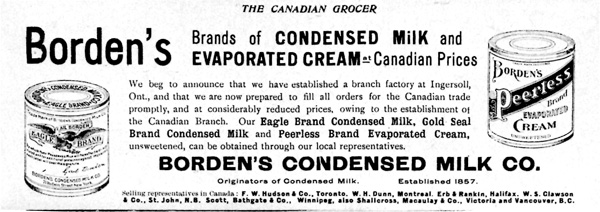
1 Borden's best-known products, 1903.
(Canadian Grocer, Vol. 17, No. 45 [Nov. 1903], p. 11)
|
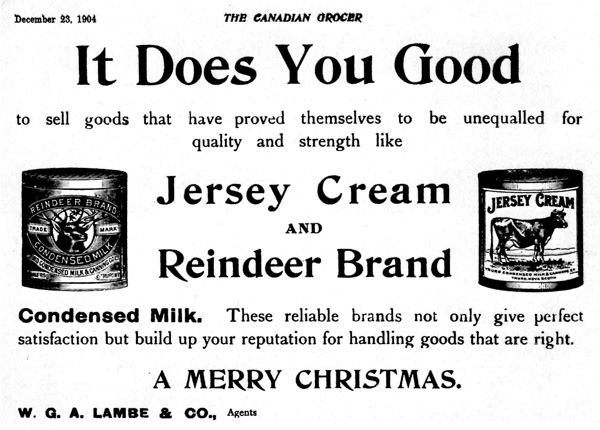
2 Condensed milk, 1904.
(Canadian Grocer, Vol. 18 [Dec. 1904], p. 5)
|
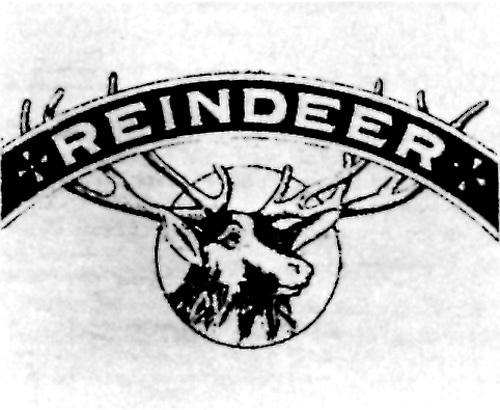
3 "Reindeer" trademark, 1919.
(Department of Consumer and Coporate Affairs, Trade Marks Registry.)
|
Other dairy products underwent similar adaptation for
use on expeditions. Vacuum-packed tinned butter never lost the early
popularity it had gained in Dawson. Packed so that it did not touch the
tin (presumably by using paper liners) this butter was reputed to
withstand the most extreme climatic conditions. J.B. Agens of Seattle
and Tacoma held a long-lasting monopoly in canned butter at the
goldfields (Fig. 4).
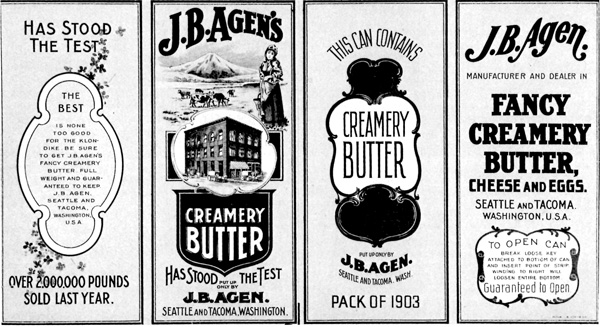
4 Agen's butter label, pack of 1903.
|
Whole eggs were useless in an outfit for obvious
reasons. To this problem the crystallized or powdered egg was the
answer. Lamont's crystallized eggs captured the Dawson market by
advertising, "No breaking. No Bad Eggs. No shells. No waste."12
Lamont had reduced the equivalent of two dozen eggs to an eight-ounce
can; to reconstitute one whole egg one needed only to add 1-1/4
tablespoons of baking powder and 2 tablespoons water or milk.
The process of concentration was not limited to dairy
products. Meat, fruit and vegetables could be reduced to a fraction of
their original weight, thereby both lightening the load and preserving
the food. Bovril was by far the best-known company engaged in reducing
meats and, to a lesser extent, vegetables. "Our object is to supply the
maximum amount of nourishment in the minimum of bulk."13 With
vast experience behind it, having outfitted prospectors, explorers,
surveyors and troops in the far reaches of the empire, the company was
up to this latest challenge. Numerous combinations of beef, bacon,
cocoa and vegetables in various reduced "cartridge" rations were
available (Fig. 5).
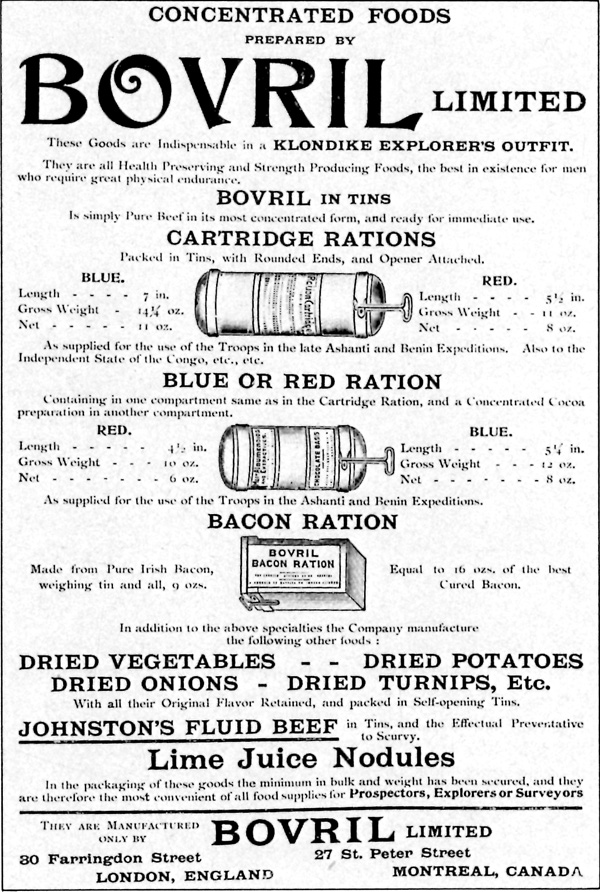
5 Bovril's cartridge rations, 1898.
(William Oglive, Klondike
Official Guid. Canada's Great Gold Fields, the Yukon . . . with
Regulations Governing Placer Mining [Toronto: Hunter, Rose, 1898], p.
xvi.)
|
Along with "Maggi" and "Vimbo's Fluid Beef," Bovril
won itself a permanent niche, not just in the well-packed outfit but
behind the counters of Dawson as well (Fig. 6). Libby, McNeill and Libby
of Chicago were prolific canners of beef in all its forms, as well as of
roast mutton, ham, tongue and soup (Figs. 7, 8). For the Klondike,
however, beef extracts had the advantage over canned products. William
Ogilvie, with the authority of a veteran surveyor in the territory,
personally advised against taking meats in tinned form.14
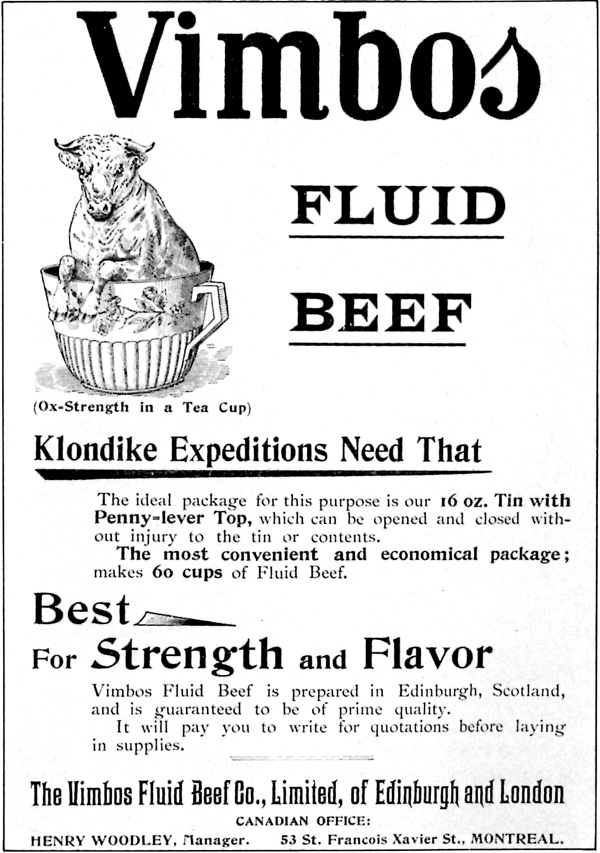
6 Vimbo's fluid beef, as advertised for the Klondike, 1898.
(William Oglive, Klondike Official Guid.
Canada's Great Gold Fields, the Yukon . . . with Regulations Governing
Placer Mining [Toronto: Hunter, Rose, 1898], p. x.)
|
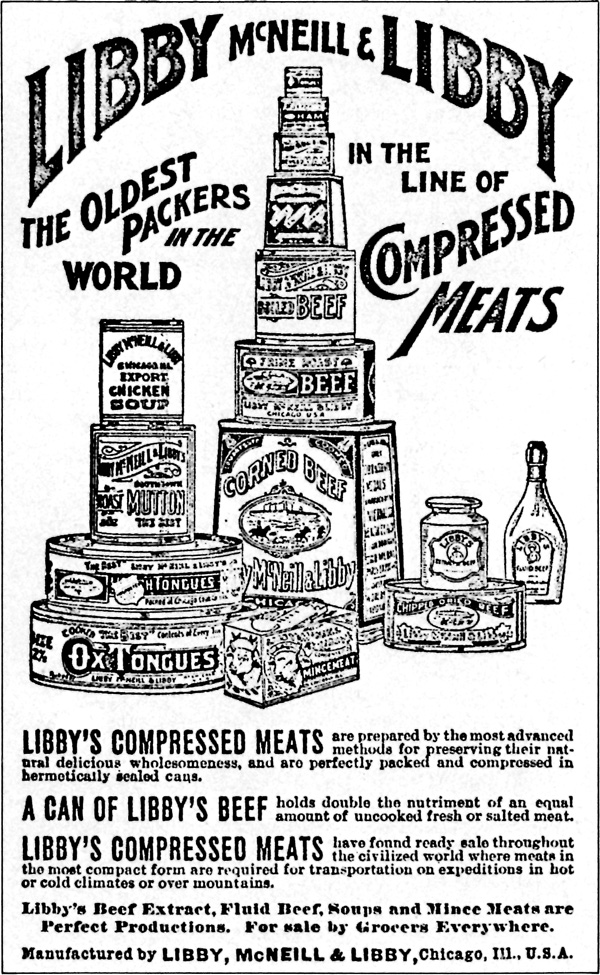
7 Libby Mcneil and Libby compressed meats, 1898.
(Source Unknown)
|
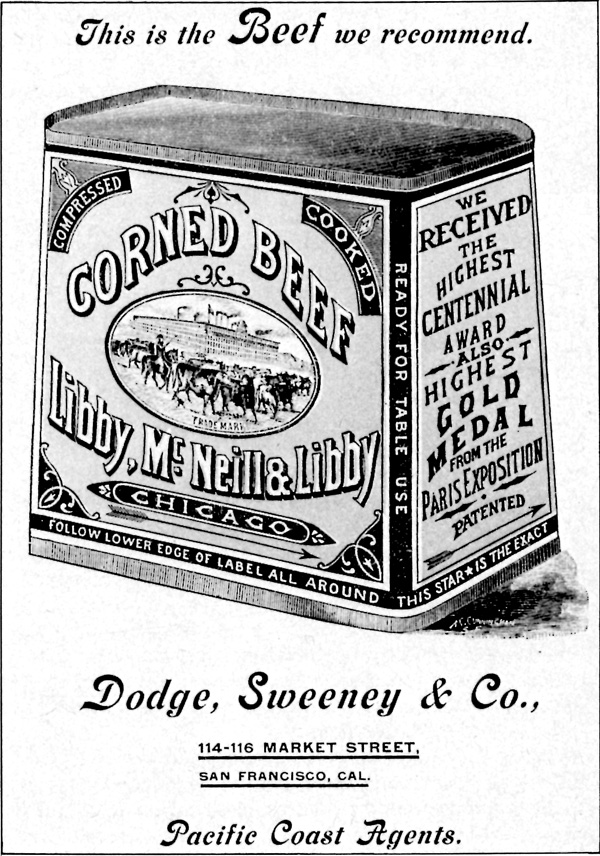
8 Corned Beef, advertised by the Alaska Commercial Company, 1898.
(Alaska Commercial Company, To the Klondike Gold Fields, and Other
Points of Interest in Alaska [San Francisco: 1898], n.p.
|
Evaporated, or simply dried, fruits and vegetables
were perfectly suited to the Klondike situation. No outfit was complete
without about 100 pounds of fruits and vegetables in this form.
Advertisements of the period lead one to believe that there was not a
fruit known to man which was not evaporated and packed for sale to the
Klondike-bound. Potatoes, sliced and dried, were especially popular.
"Lubeck" was a brand of dried potatoes which sold consistently in
Dawson, but it is not known whether it was produced initially for the
outfit trade or not.
From the point of view of a world accustomed to
frozen foods and chemical additives, the number of processes in use at
the end of the century to reduce and preserve foods — all in the
name of lightness and durability — is surprising. The prospector's
diet was not simply canned; it was evaporated, concentrated, dessicated,
compressed, liquified, crystallized and granulated. His beef and sugar
(not to mention his lemons, limes, celery and milk) might come in
tablets; his coffee and tea in lozenges, his cocoa in cakes. One
extremist managed to put together an outfit made up exclusively of such
drastically reduced foods as these which, when complete, weighed a mere
69-1/2 pounds.15 In describing this quintessence of
gastronomic delight, the author of the publication reported with a
remarkable evenness of tone: "Almost everything comes in a powder or a
paste, and needs nothing but boiling water and an appetite to make a
meal."16 It is easy to imagine the monotony of food in the
cabins and on the trail. No doubt the least concentrated and most
appetizing goods were consumed first. For the last months in the season,
the remaining evaporated delicacies must have exhibited a dreary
sameness.
Whether the contents were whole, canned or dried, the
trend toward the use of brand-name food products was a significant one.
In an age of abundance and expansion in the food processing and packing
industry, adulteration had become an established practice. Since there
was still little effective legislation enforcing inspection and other
controls in either the United States or Canada,17 those
brands which guaranteed the purity of their products in their
advertising gained respectability in the market. The AC Company, in its
promotional Klondike pamphlet, included testimonials from no less an
authority than Jack McQuesten for brands considered trustworthy over the
years. His support of Eagle Brand milk is indicative of the general
trust put in known varieties.
There is nothing more precious, perhaps, to a
miner in the Arctic than a can of good condensed milk or cream. This is
so well known in Alaska that the Miners there will buy nothing but the
"Eagle" brand, but it is the ignorant miner — and only the ignorant
miner — that is fitting out in San Francisco or Seattle who ever
allows any other brand to be foisted on him, and he will find out when
he reaches Alaska, where the temperature is 80° below zero
sometimes, that his cheap, inferior milk is no good.
18
A similar endorsement was given to "Royal" baking
powder, the only kind (according to the AC Company) which would with
stand climatic conditions "harsher against baking powder than against
anything else." Other brands singled out for commendation were "Germea"
breakfast cereal (highly concentrated and nutritive, quick-cooking and a
preventative of scurvy), Sperry's "Drifted Snow" flour (for its dryness)
and Baker's cocoa and chocolate (withstanding extreme conditions, and
also preventing scurvy) (Fig. 9).
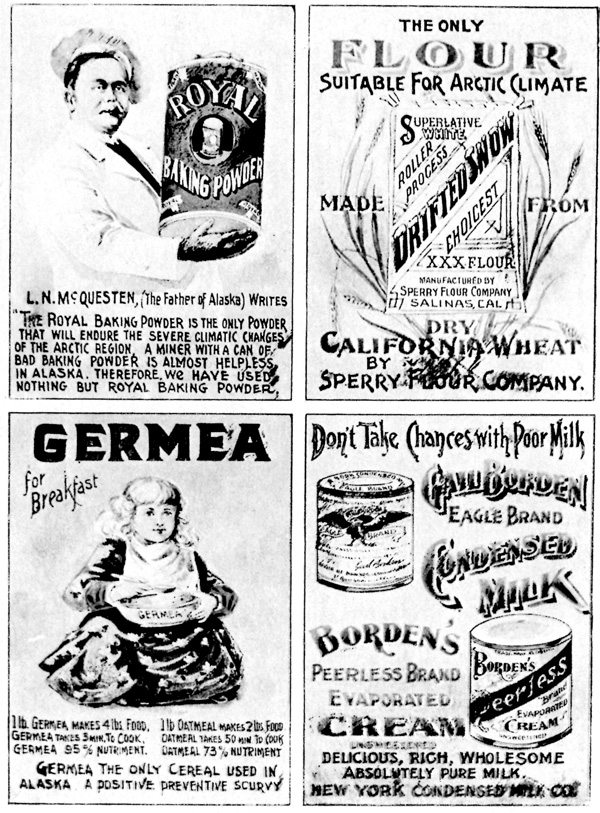
9 Endorsements by Jack McQuesten, 1898,
(Alaska Commercial Company, To the Klondike
Gold Fields and Other Points of Interest in Alaska [San Francisco,
1898], n.p.)
|
William Ogilvie was an experienced and more impartial
adviser. Less concerned with specific brands, he offered such general
sound advice as the fact that good fatty bacon, oatmeal and good black
tea ("the cup that cheers but not inebriates") should all be included in
an outfit for their warming qualities. Good medium flour and ordinary
brown beans were the most sensible investments in their kinds. Good
quality granulated sugar was preferable to brown, which was more apt to
freeze in winter.19
Unfortunately, the health of the miner was not the
concern to outfitters that it might have been. While some guides
included advertisements by wholesale druggists, only about a quarter of
the lists collected for this report included a medicine kit —
usually a $4 or $5 package. One advertisement for a "health regulator"
struck at the grim but realistic truth that miners and suppliers, in
their mutual haste to strike gold, ignored "Don't kill the goose that
lays the golden egg. Your future wealth depends upon your present
health. Take care of it in your own interests."20 One
reporter for the Chicago Record, who had already made the
overland trip, bemoaned the fact that so very little importance was
attached to the medical chest. He suggested the following useful items:
liniment for sprains and cold on the lungs, tincture of iron to
enrich the blood, extract of Jamaica ginger, laudanum, vaseline,
carbolic ointment, salts, cough tablets, mustard and adhesive plaster,
surgeon's lint, bandages, liver pills, powder for bleeding, absorbent
cotton, surgeon's sponge, needles and silk, quinine capsules and
toothache drops.21
While scurvy from a poor, unvaried diet was indeed a
grim possibility, those miners who listened to any expert advice were
clearly aware of the dangers and packed preventatives accordingly. One
encouraging feature of this gruesome disease was its amenability to
treatment in all but its most advanced stages.22 The
well-known role of ascorbic acid in its prevention and cure was
acknowledged in many outfits by the inclusion of lime juice or tablets
of citrus fruit extract containing the acid. "Montserrat Lime Fruit
Juice" and L. Rose and Company's lime juice were both reputable
products. While most of the goldseekers were probably unaware of the
fact, canned tomatoes also contained the necessary vitamin
C.23
An additional worry for the miner was that not every
company which put up medicine boxes with their supplies could be trusted
to fulfill the task knowledgeably or honestly. Her discovery that
certain drugs were missing from her medicine chest drove one
Klondike-bound traveller to write angrily that "merchants seem to
think that when they outfit you for the Klondike thay
can put upon you all the stuff that no one else will take and that they
will never hear from you again."24 Given the suddenness of
the Klondike phenomenon, the customers' general eagerness and their
ignorance, both of their needs and of their suppliers, dishonesty must have
been fairly common among the less scrupulous merchants in the trade. The
number of reported grievances, even in private papers, is surprisingly
low.
The food discussed above made up the basic provisions
outfit taken by the wise miner. There were those, of course, whose
tastes ran to such portable treats as cake and cookies, pickles, spices,
cheese and jellies. Like the treasured tobacco supply, these delicacies
were probably consumed before Dawson came into view.25 Such
luxuries did have an additional value; they could be used for purposes
of barter along the trail. While the intelligent traveller knew that it
was sheer folly to weight one's pack more than was absolutely necessary
with these extra pots and jars, one with a certain enterprising spirit
looked at the situation in a different light. He was almost sure to meet
some fellow gold-seeker, desperate in his deprivation, who was willing
to pay almost anything for a plug of "Old Chum" or a tin of "Log Cabin"
maple syrup.
In the line of clothing, one comes across general
types of garments offered by most outfitters rather than specific brand
names. The most important items were heavy lined suits of mackinaw (a
blanket-like wool, either grey or plaid), wool, tweed, serge, corduroy,
khaki or waterproofed cotton duck. Under this went heavy sweaters,
woollen socks and knit underwear. The most descriptive selection of
Klondike clothing was offered by the T. Eaton Company in a special
Klondike section of their fall and winter catalogue for 1898 (see Fig.
10). Items "B" and "C" are Shorey's "Patented Blizzard Resister Suits"
and item "G" is the Klondike shirt made by the same company (Fig. 11).
These articles were still being distributed through Eaton's long after
the gold-rush had subsided.

10 Klondike clothing featured by the T. Eaton Company, Spring and
Summer Catalogue (No. 40) 1898.
(The Archives, Eaton's of Canada
Limited, The T. Eaton Company Limited Catalogue, 1898, p 124.)
|
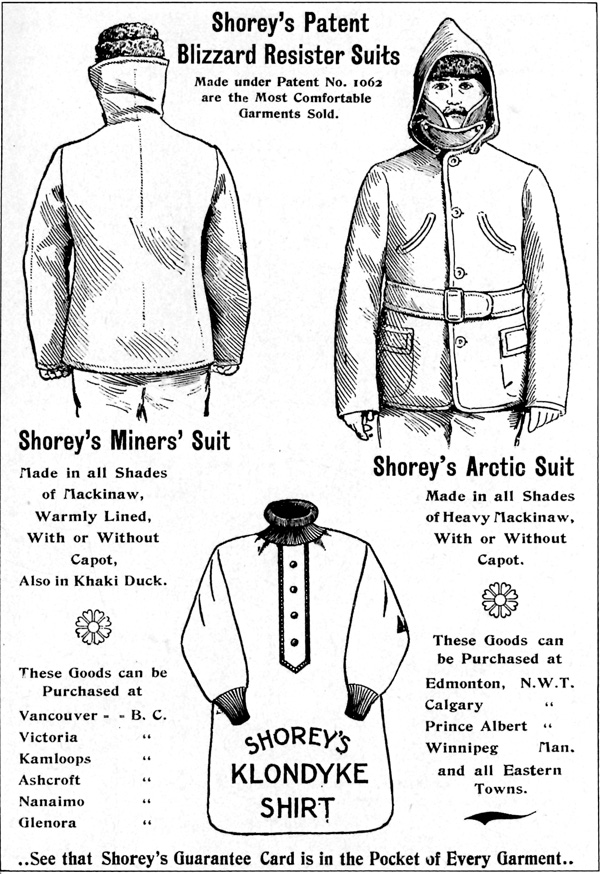
11 Shorey's famous shirts and suitss.
(William Ogilvie, Klondike Official Guide,
Canada's Great Gold Fields, The Yukon . . . with Regulations Governing
Placer Mining [Toronto: Hunter, Rose, 1898], p. xxvii.)
|
Several companies offered everything from robes to
parkas, pants, hats and mittens in fur. Few goldseekers, however, could
afford fur robes and, because of the greater freedom of movement
afforded by fabric clothing, the native skins (as they were called in
the Yukon) were more attractive to those not actively engaged in
mining.26 Instead of fur robes, most buyers would be
satisfied with several heavy blankets, available for less than $10,
along with an oilcloth cover. The sleeping bag was gaining popularity,
as the Eaton's catalogue shows. Usually of oiled, rubbered or plain
cotton, it was lined with eiderdown, fur, wool or felt and cost between
$10 and $20 (Fig. 12).
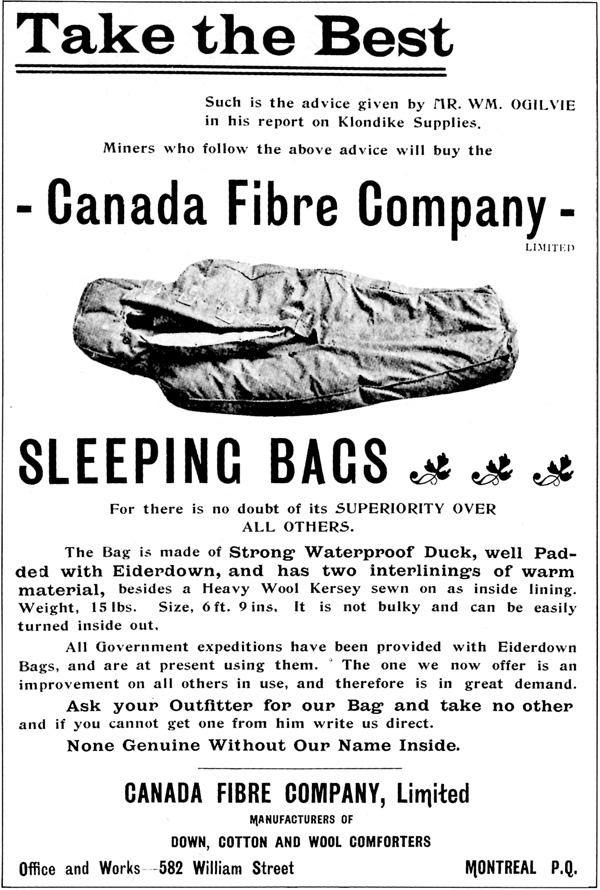
12 Advertising by association in the Ogilvie guide.
(William Ogilvie, Klondike Official Guide,
Canada's Great Gold Fields, The Yukon . . . with Regulations Governing
Placer Mining [Toronto: Hunter, Rose, 1898], p. xxxviii.)
|
As for boots, the miner would have to be outfitted
with two distinct types. Winter definitely called for "native boots" or
mukluks, which could be purchased in the north.27 For the
spring mud along the creeks, rubber boots were essential. Several pairs
of snag-proof, unlined hip-waders were advisable. This was one area of
the clothing outfit where brand names did emerge. The AC Company stood
behind the patented snag-proof and crack-proof "Gold Seal" products of
the Goodyear Rubber Company of San Francisco. In Vancouver, "English
K-boots" ("guaranteed absolutely waterproof, snagproof gum boots") were
advertised,28 while the Canadian Rubber Company of Montreal
offered the "Alaska Mining Boot" (Fig. 13). Waterproof rawhide boots
were popular; they were more suitable for the arduous trails than for
the final muddy destination. George T. Slater and Sons of Montreal
produced a boot for $8 that remained a well-known brand in Dawson (Fig.
14).
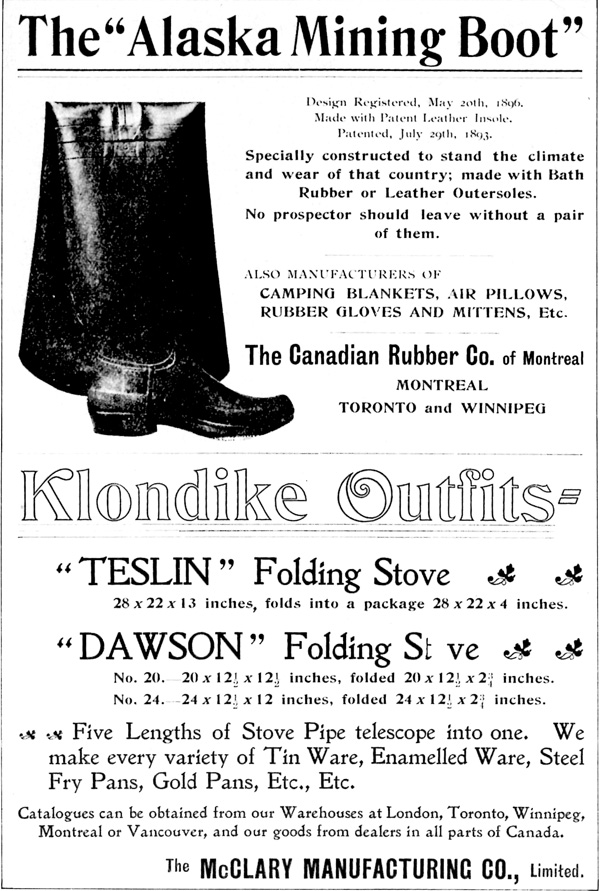
13 The Alaska Mining Boot, from the Canadian Rubber Company (Montreal,
Toronto, and Winnipeg), 1898.
(William Ogilvie, Klondike Official Guide,
Canada's Great Gold Fields, The Yukon . . . with Regulations Governing
Placer Mining [Toronto: Hunter, Rose, 1898], p. xliv.)
|
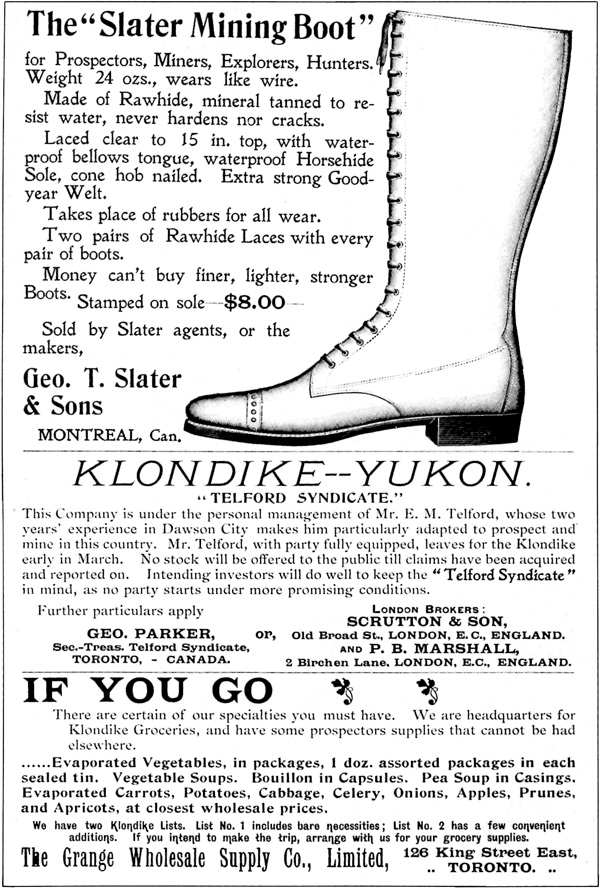
14 The Slater mining boot, 1898 — consistently popular in outfits
and (later) in Dawson.
(William Ogilvie, Klondike Official Guide,
Canada's Great Gold Fields, The Yukon . . . with Regulations Governing
Placer Mining [Toronto: Hunter, Rose, 1898], p. xxxvii.)
|
Completing the clothing outfit were heavy wool socks,
called arctic socks or often "German wool socks," underclothing (Jaeger
flannel was common), mosquito netting and snow goggles. Depending on the
season in which one started north, one of the last two items would be
essential to one's travelling comfort. Again, the brand names made
popular by the strike remained so in Dawson stores.
The hardware list in the outfits sold by McDougall
and Secord was much like the one recommended by Ogilvie
himself.29 In addition to the tools and utensils which must
have been familiar to all woodsmen and explorers, certain items were
particularly adapted to the life and survival of the Klondike miner. The
gold pan and scales were obvious inclusions, as were pick and shovel.
In the hands of a resourceful miner, the pan could be used both as wash
basin and bread pan.
A more significant addition was the collapsible camp
stove. Often called the Yukon stove or Klondike camp stove, this article
was considered to be a unique northern adaptation. Its origin was
claimed by the city of Seattle.30 Its worth can be attributed
to its collapsibility. The sides of the box-like stove folded, and the
pipe telescoped into four or five pieces (Fig. 15). It could be carried
easily, although it was, after all, made of sheet-iron. (One model was
advertised as weighing a mere 17 pounds.)31 It was a compact
piece of work, about 9 inches by 12 inches by 24 inches, and its design
was such that "even on the coldest days it could keep a properly chinked
and roofed cabin uncomfortably warm."32 Often the tank of the
stove was divided between fire box and oven. While the box-shaped model
might have from two to five lids, there was a half-barrel and a
cylindrical shape as well which served only as heater and oven. Since it
was both absolutely necessary as well as relatively simple to construct,
this article was soon manufactured right in Dawson.33
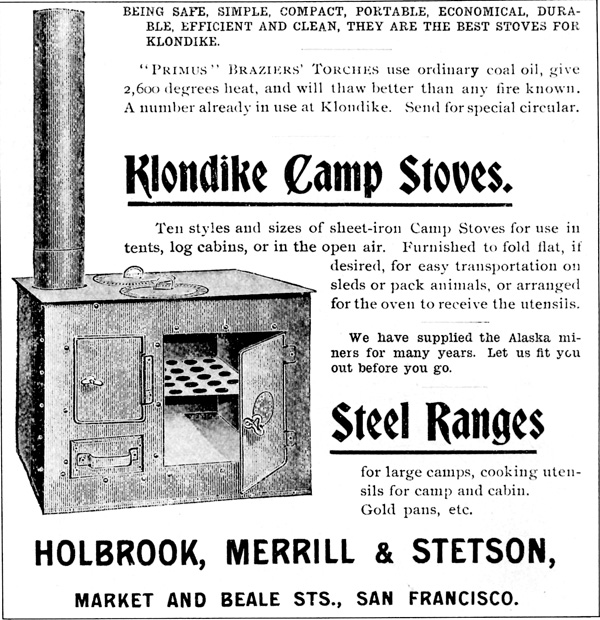
15 One version of the collapsible Yukon stove.
(Alaska Commercial Company, To the Klondike
Gold Fields, and Other Points of Interest in Alaska [San Francisco:
1898], n.p.)
|
Another peculiarity of the Klondike outfit, intended
for those miners crossing the passes, was the inclusion of tools and
materials (other than lumber) necessary to build a craft to descend from
the head of Bennett Lake to Dawson City. These included a whipsaw,
crosscut saw, pitch, oakum, caulking iron, hammer and nails, jack plane,
chisel, brace and bits, knife and rope. For those who wished to avoid
the delay of having to build a boat, portable sectional canoes were
sold.34
The problems encountered by the miner who discovered
too late that his outfit contained useless quantities of goods have
already been mentioned. In the case of an excess of hardware or food,
the packs were either jettisoned or traded off, depending on the
relative demand for the product.35 In this way booths stocked
with the leavings of disheartened goldseekers became a familiar feature
along the Trail of '98. For those who ran them, this was often the first
step to a lifetime's work of merchandizing in the north.
The sudden demand for nearly a ton of supplies for
each of tens of thousands of adventurers was an unexpected shot in the
arm for the food supply industry across the continent. The news of the
Klondike gold finds which had arrived in July of 1897 with the first
nugget-laden ships, Excelsior and Portland, must have
excited astute wholesale dealers along the steamship routes. It opened
the possibility not only of profiting from the outfitting trade, but of
eventually earning a share of the market at the gold fields for as long
as the capricious paystreak would support one.
Of the west coast cities in competition for the
outfitting trade — San Francisco, Seattle, Portland, Tacoma,
Victoria and Vancouver — all had some experience in the business.
San Francisco, of course, had the edge on the rest of them, being the
supply depot and port for the pioneer AC Company. During the previous 20
years, however, Seattle had begun to catch up; her productive hinterland
had been greatly expanded by the arrival of the Northern Pacific Railway
at her back doorstep in 1885.36 By the early 1890s she had
gained a secure monopoly of the trade to Juneau, the commercial centre
for the hard-rock gold mining operations conducted on the Alaskan
panhandle since 1880,37 and in 1897 had been an outfitting
base for some of the first Klondikers over the passes.38 The
feather in Seattle's cap, and an event which launched her into serious
competition with San Francisco, was the decision of the newly formed
NAT&T Company to use Seattle as its Pacific coast
entrepôt.39
The Canadian ports of Victoria and Vancouver had both
earned admirable reputations as wholesale supply and outfitting centres.
With 50 years of experience under their belts in servicing the Cariboo,
Cassiar and Kootenay gold-rushes, they were recommended by William
Ogilvie in his Klondike Official Guide for the outstanding
usefulness of their goods.40
Also experienced, but in a less favourable location,
were the northwest centres of Edmonton, Calgary and Prince Albert.
Undaunted, these towns publicized the overland route (via the Mackenzie
watershed).41 While Edmonton merchants did indeed manage to
profit from the gold-rush,42 they could hardly continue
shipping goods along the impossible and tortuous wilderness route which
they had once urged the goldseekers to follow.
The spoils, in terms of continuing trade with the
Yukon, were divided, therefore, among those cities on the Pacific water
routes. It was to Seattle that the greatest number of Klondikers
thronged. This was the hard-earned fruit of a publicity campaign run by
the Seattle Chamber of Commerce, whereby advertising was carried on
through mayors, postmasters, public libraries, railways and newspapers
across the nation.43 In terms of an intense, immediate and
far-reaching reaction to the news of gold, no city was able to match it.
By the time other cities tried to adopt Seattle's methods, that city's
initial monopoly had been established.44 The first year's
reward for Seattle merchants was an estimated $10
million.45
During the previous decade of commercial success,
several Seattle firms had begun to flourish in the general grocery and
wholesale hardware line. The well-known wholesalers included the
Schwabacher Brothers, Seattle Trading Company, Harrington and Smith
(bought out by A.E. MacCulsky in 1893) and Fischer
Brothers.46 As for the food processing industry, the farming
country around the city produced quantities of raw materials for the
much-needed staples — condensed milk, evaporated or dried fruits
and vegetables and food extracts. A look at various lists of outfits
shows that, while Canadian firms were competitive on some counts (flour,
bacon and some fresh produce, for example), for the most part Seattle
could pack provisions more cheaply. To market these products in the form
of outfits, a new type of wholesale firm emerged that dealt mainly in
groceries.47 The dealers, supported by the Klondike trade,
could handle the large demands in provisions and could outfit
prospecting parties. Individual consumers had to buy from large
retailers who could handle the range of single orders for the Klondike.
An example of such a foods broker was the firm of Frank and May, which
in 1895 advertised as manufacturers' agents. Various small industries
had recently grown between railhead and port. In combination with the
existing lumbering industry, these had also converted Seattle into a
strong hardware-producing centre.48
One significant feature of Seattle's successful
outfitting business was the organizaton that pervaded the trade early in
the game. The descriptive article which follows appeared in the Toronto
Globe in February 1898.
[The Seattle merchants] began to see not lists of
goods in various lines but outfits. They prepared and packed complete
outfits containing every thing necessary for the trip and a year's
sojourning in the arctic placers. Intending Klondikers were not obliged
to inquire of experts regarding their future needs and to hunt about
among a number of stores to obtain supplies. They could find their
hardware, groceries, furs, clothing, tools, cooking utensils, etc. all
ready packed and ticketed as to weight and price at the outfitter's
store. An outfit for one, two, three or four persons could be obtained
without delay and without the risk of overlooking anything essential.
This trade was fully established in Seattle while the British Columbia
merchants were still adhering to their own lines of supplies and causing
their customers to go from store to store when buying
outfits.49
Seattle's other advantage lay in the official realm
of customs regulations. As long as there were no Canadian customs
officers at the summits of the passes (that is, at the international
border) Americans could bring in their supplies duty-free, avoiding the
tariff that, for the commodities in question, ran between 25 and 30 per
cent on the average. Although this loophole was plugged by the Canadian
government by August 1897,50 Seattle's "duty-free" reputation
had been established. Ironically, it was still the Canadian-based
Klondiker who suffered at the border. Until May 1898, American bonding
regulations on Canadian goods were so severe and convoying fees across
the panhandle so high that it was simpler to pay American duties at
Dyea.51
As in Seattle, it was the wholesale dealer in
Canadian centres who was most prepared to outfit. As the Globe
article quoted above indicates, however, trade in Victoria and Vancouver
was handled to a larger degree by specialists. In Vancouver, for
instance, there were over twice as many wholesale grocers as either
hardware or dry goods firms advertising in the "Holiday Klondike
Edition." Lugrin's Yukon Gold Fields shows a preponderance of
clothing merchants in Victoria. In tools and hardware, the name
McLennan, McFeely and Company is irrevocably attached to any reference
to Vancouver's role in the gold-rush.
It appeared at first that Seattle's main source of
competition would come from the active British Columbia port of
Victoria. Indeed, the Victoria Daily Colonist's first Klondike
outfitting advertisement for miner's clothing outfits from Marks'
appeared on 20 July 1897, only a few days after the news brought by the
Excelsior and Portland had burst on the world. Victoria's
campaign gained momentum throughout that first month and rose to an
early peak with the publication of the pamphlet Yukon Gold Fields
by Charles Lugrin, the Colonist's editor. Heavily supported by
local merchant advertising, the publication sold well in eastern Canada,
where the Victoria Board of Trade intended to focus its advertising
resources.52
Bypassed by Klondike-bound steamers from both Seattle
and Victoria,53 Vancouver had a poor position in the opening
lineup. Not until the new year, when two CPR steamers were transferred
to the Vancouver-Skagway run, were Vancouver's inadequate shipping
facilities increased to the point where it could compete as a point of
departure.54 Consequently, the reaction of Vancouver's
business sector to the rush past its door was a belated one. Sporadic
Klondike advertising in the Vancouver Daily World was not
replaced by impressive and consistent daily copy until after the
"Holiday Klondike Edition" came out on 31 December 1897. Once fully
mobilized, however, the Vancouver outfitting trade reached its peak
between February and June 1898.
The notable exception to specialized outfitting on
the Canadian west coast was the Hudson's Bay Company, the most seasoned
provider of them all. While the company's advertising was kept to a
low-keyed minimum, they announced in the spring of 1898 that they were
unable to keep abreast of orders.55 One can easily appreciate
the pace of their business in Vancouver in March 1898:
It is like a trip from Paris to Siberia to take
the elevator from the fashionable lower floors of their block to the
uppermost storey where piles of every conceivable supply for an arctic
zone from dessicated potatoes to moosehide moccasins are scattered
around while the busy clerks sell, pack and shift the goods away.
56
Another account of outfitting in that city, in
February 1898, maintains that, in those grocery and hardware stores
doing the most roaring business, shelves were completely empty by
nightfall. This report singles out druggists as a third group to profit
greatly from the rush, "furnishing men and women with different
medications to fight scurvy, and especially unguents to discourage black
flies and mosquitoes."57
The initial outfitting rush was short-lived; it
lasted only until the end of the 1898 season.58 By the fall
of that year, Vancouver and Victoria merchants alike were plagued by
overstocked shelves.59 The battle between Seattle and
Vancouver continued, but from then on it was to be fought over the
long-term privilege of supplying Dawson retailers. While Victoria had
originally seemed the most likely rival to the American port, her
position was in fact taken over by Vancouver. Once the two cities'
shipping was equalized, Vancouver's rail connections with the east
earned her a more advantageous position from which to deal with incoming
goods and goldseekers.
One very significant outcome of the outfitting rush
was the keen and continuing interest in the Yukon trade which was
generated by the outfitting experience of several Vancouver merchants.
The Oppenheimer Brothers, commission merchants, importers and wholesale
dealers in groceries, provisions, cigars, tobaccos and so forth, were
leading participants in the Vancouver Board of Trade's campaign to wrest
the Yukon trade monopoly from Seattle.60 McLennan, McFeely
and Company lost no time in establishing one of the earliest hardware
and tinsmithing businesses in Dawson61 (Figs. 16 and 17).
McLennan himself moved north to manage the outlet, becoming Dawson's
mayor in 1903. Thomas Dunn and Company, another wholesale hardware firm,
made a long-lasting contact as one of the largest single suppliers of
the Dawson Hardware Company. Kelly Douglas (in wholesale grocery
supplies) remains to this day as familiar a name in the Yukon merchant's
vocabulary as "Mc & Mc."
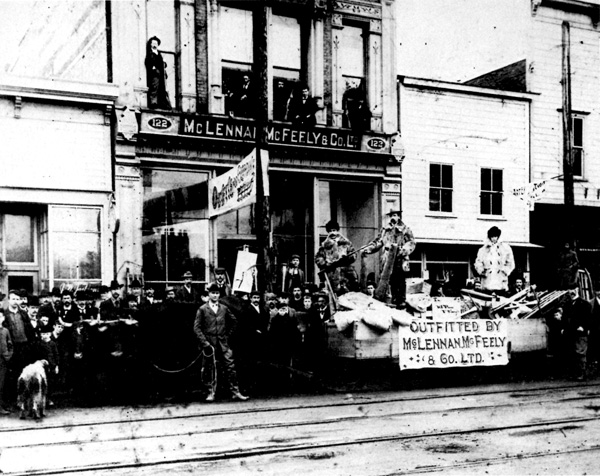
16 McLennan, McFeely and Company; outfitting for the Klondike from
New Westminster, B.C.
(Centennial Museum, Vancouver)
|
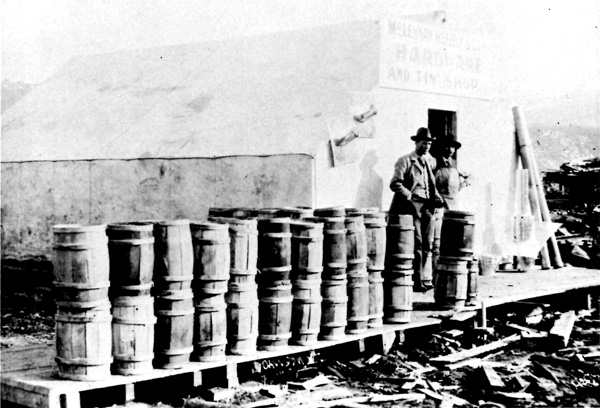
17 The first Dawson headquarters of "Mc & Mc"s hardware store
and tinshop, ca. 1898.
(Public Archives Canada, PA 13497.)
|
Calgary, Edmonton and Prince Albert were all
recognized as experienced outfitting centres,62 and enjoyed
in addition the reputation of being the gates to the only all-Canadian
route to the Klondike. Despite the rigours of the long overland haul
along the Athabasca and Mackenzie rivers, it was a much-promoted route.
Not the least enthusiastic of its promoters were the Toronto and
Montreal suppliers who stood to profit directly from extensive
outfitting in the northwest.63 To the disappointment of all
business interests concerned, the all-Canadian route never became a
major shipping route to the Yukon.
While the outfits offered in these centres were
complete in all areas, the prices were higher than on the coast (with
the exception of those for flour and bacon).64 Along with the
Hudson's Bay Company, which had branches in Winnipeg, Calgary and
Edmonton, the firms of McDougall and Secord and of Larue and Picard
offered complete outfitting services in Edmonton. In Prince Albert, the
majority of establishments were the experienced type of "general
merchants and Indian traders...in the north for 15 years" who could
outfit a man with everything from picks to packaged
potatoes.65
While at first glance it seems that the spoils of the
Klondike rush went to Pacific coast merchants, Montreal and Toronto
enjoyed a steady growth in the areas of importing, processing,
manufacturing and distribution which permanently expanded their
lucrative western market. It is worth noting at this point that the
Toronto Board of Trade believed itself to have been influential in
securing bonding privileges in Alaska more suitable to the entry of
greater volumes of Canadian products.66 While the names of
Seattle and Vancouver distributors became bywords to the thousands of
Klondikers they supplied, eastern manufacturers immediately understood
the potential profit in establishing their brands in the north through
these agents.
Outfitting was not a recent tradition in eastern
centres. Estimates of the extent of individual outfitting in Montreal
and Toronto as opposed to other cities are based on sketchy information.
While there are few personal accounts which relate experiences of
eastern outfitting, advertising in the Globe was considerable,
and articles early in the 1898 season made much of Toronto's advantages
as a starting point for the Klondike. One could outfit as early as
possible, prices were lower, superior goods were assured and through
freight rates were available.67 Montreal in that period is
reported to have had the exclusive privilege of outfitting British
goldseekers entering Canada at that port.68
It was the newly stimulated food processing industry
that was to earn outfitting prominence for these cities. The sudden
flourishing of advertisements for suppliers and their jobbers, geared
toward the Klondike outfitter, was a salient feature of the Canadian
Grocer trade magazine early in 1898. One of its first issues that
year states that "quantities of evaporated vegetables, carrots, onions
etc., are being put upon the market in concentrated and convenient form
for the Klondyke trade."69 The Tillson Company of
Tillsonburg, Ontario (split peas, kiln-dried), the Acme Dried Vegetable
Company and the Kerr Vegetable Evaporating Company all focused their
energies on supplying the Klondike through grocery jobbers and
agents.70
The canning industry was another to benefit from the
suddenly increased west coast demand. W. Boulter and Sons of Picton,
Ontario, shipped two CPR carloads of "Lion" brand canned corn to
Vancouver and San Francisco. By June of 1898, 3,500 cases of the
upcoming pack of tomatoes and corn were reported ready to
follow.71 While rumours of spectacular deals between eastern
firms and Yukon trading companies continued to fly,72 actual
market reports of unusually brisk trade in wholesale canned goods gave
backing to the optimistic speculation.73
Importers, especially those in Montreal, gained the
agency for several Klondike-bound British products. Bovril, Vimbo's
Fluid Beef and E. Lozenby and Son's soup squares were all British
products sold through such Montreal dealers as A.P. Tippet and Company
of Montreal and Toronto.74 One unnamed German manufacturer
was allegedly doing well on the west coast and among eastern
wholesalers, selling a product which had known 15 years of consistently
slack markets.75 Demand for his line of assorted evaporated
vegetables reached dizzying proportions, thanks to the Klondike.
The commercial link between Ontario food packers and
British Columbia outfitters was firmly maintained throughout the
gold-rush and beyond by a relatively small and secure group of food
wholesalers that jobbed (that is, distributed) the manufacturers' goods
among western retailers. W.H. Seyler and Company, Eby, Blain and
Company, Warren Brothers, and Davidson and Hays, all of Toronto,
furthered their reputations as reliable distributors and thereby
profited greatly, albeit indirectly, from the great discovery of
1896.
As the rush of individual goldseekers over the passes
was a phenomenon of the winter and spring of 1898, the frenetic attempt
to provide necessities to these men faded when their goal was reached.
During the summer of 1898, once the mass of goldseekers had reached
Dawson, a new supply system took over. The simplest statement that one
can make about the fascinating mercantile mosaic of that summer is that
trade was largely a matter of reselling the tens of thousands of tons of
goods which arrived at the waterfront. This activity resulted in acute
shortages in certain areas, exorbitant prices and uncertain quality of
goods. These elements of unpredictability made for a chaotic, if
picturesque, throng of companies, storekeepers, jobbers, pedlars and
simple dealers.
As the shipping season closed, after the
faint-hearted had sold out their outfits and gone home, it became clear
that "starvation" winters, at least, were a thing of the past. Since few
would venture into the Yukon valley before the next spring, the
outfitting trade suffered a predictable slump. As such, the end of the
1898 shipping season marks a point of transition. For many outfitters,
contact with the wealth of the Klondike would be limited to the early
enthusiasms of 1897-98. For the larger, more experienced and more
persistent companies, the initial rush would turn out to be more than a
flash in the pan. Klondike gold was indeed going to hold out, and since
their foundations had been successfully laid in the previous year or
before, these companies would be the ones to reap the benefits of the
new trade patterns by becoming steady wholesale suppliers to the Dawson
merchants. To extend their bonanza, they had only to come to grips with
the combined problems of distance, terrain and climate in order to
supply the motley Dawson market with whatever it wanted — for as
long as gold held out.
|
 |
 |
|

